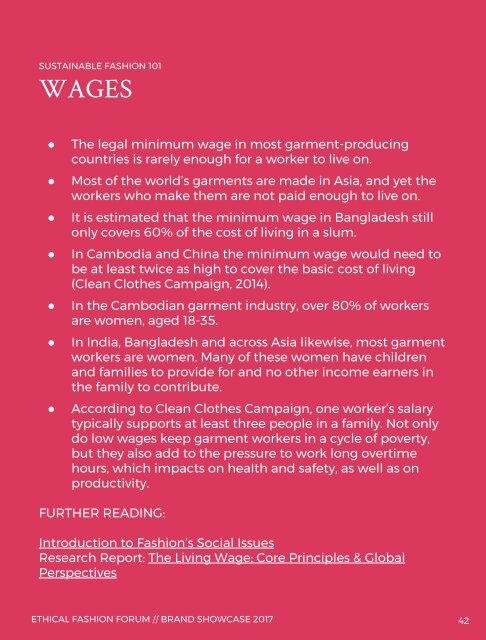Sustainable RTW: The New Norm
You also want an ePaper? Increase the reach of your titles
YUMPU automatically turns print PDFs into web optimized ePapers that Google loves.
SUSTAINABLE FASHION 101<br />
WAGES<br />
●<br />
●<br />
●<br />
●<br />
●<br />
●<br />
●<br />
<strong>The</strong> legal minimum wage in most garment-producing<br />
countries is rarely enough for a worker to live on.<br />
Most of the world’s garments are made in Asia, and yet the<br />
workers who make them are not paid enough to live on.<br />
It is estimated that the minimum wage in Bangladesh still<br />
only covers 60% of the cost of living in a slum.<br />
In Cambodia and China the minimum wage would need to<br />
be at least twice as high to cover the basic cost of living<br />
(Clean Clothes Campaign, 2014).<br />
In the Cambodian garment industry, over 80% of workers<br />
are women, aged 18-35.<br />
In India, Bangladesh and across Asia likewise, most garment<br />
workers are women. Many of these women have children<br />
and families to provide for and no other income earners in<br />
the family to contribute.<br />
According to Clean Clothes Campaign, one worker’s salary<br />
typically supports at least three people in a family. Not only<br />
do low wages keep garment workers in a cycle of poverty,<br />
but they also add to the pressure to work long overtime<br />
hours, which impacts on health and safety, as well as on<br />
productivity.<br />
FURTHER READING:<br />
Introduction to Fashion’s Social Issues<br />
Research Report: <strong>The</strong> Living Wage: Core Principles & Global<br />
Perspectives<br />
ETHICAL FASHION FORUM // BRAND SHOWCASE 2017<br />
42
















